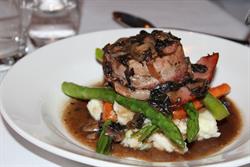
COURSE STRUCTURE
Duration: 600 hours
This course is made up of 6 modules: four compulsory and two elective:
Click on modules for more detail
Compulsory:
Human Nutrition 1
Human Nutrition 11
Human Nutrition 111
Life Coaching
Elective: Select two of the following.
Sports Nutrition
Children's Nutrition
Nutrition for Weight Loss
Biochemistry l (Animals)
Anatomy and Physiology (Human)
Introduction to Psychology
MODULE OUTLINES
Human Nutrition I
There are nine lessons in this course as follows:
1. Introduction to Nutrition.
2. The Digestive System
3. Absorption and Enzymes
4. Energy Value and Foods
5. Carbohydrates and Fats
6. Proteins
7. Vitamins and Minerals
8. Water
9. Nutrient Disorders
What You Will Do In This Course
- Distinguish between nutrition terms including: food, nutrition and diet.
- Distinguish between characteristics of all major food groups, including chemistry and foods which are a good source.
- Explain the significance of the major food groups, including: Carbohydrates, Proteins, Fats, Minerals, Vitamins.
- Label on unlabeled illustrations, parts of the digestive system.
- Explain the function of different parts of the digestive system.
- Distinguish between digestion and absorption of food.
- Explain the different layers of the digestive tract, including: mucosa, submucosa, muscularis, serosa.
- Explain 3 different physiological processes involved in absorption
- Explain how different hormones control the digestive process, including: gastri, gastric inhibitory peptide, secretin, cholecystokinin.
- Explain the action of three different digestive enzymes.
- Describe how the intake of different types of food may affect metabolic rate.
- List foods which are a common sources of carbohydrate.
- Explain three factors which affect the bodies demand for carbohydrate.
- List foods which are a common source of fats.
- Distinguish between saturated and unsaturated fats in the diet of a specific person.
- Develop a set of guidelines to determining appropriate fat intake, in accordance with an individual's specific requirements.
- Explain the role of protein in the body, including examples of two physiological processes involving protein.
- Explain the role of ten different minerals in the body.
- Explain the role of water in the body, for five different physiological processes.
- List factors which affect the body's requirement for water.
- Describe three different techniques used by health practitioners for determining food/nutrition disorders
Human Nutrition II
The content of each of the eight lessons is outlined below:
- Cooking And Its Affect On Nutrition
- Food Processing And Its Affect On Nutrition
- Recommended Daily Intake Of Nutrients
- Vitamins
- Minerals
- Planning A Balanced Diet
- Assessing Nutritional Status And Needs
- Timing Of Meals, And Needs For Special Groups
What You Will Do In This Course
- Explain reasons for cooking food.
- Compare different methods of cooking food in terms of their effect on both health and nutrition.
- Explain the effects on nutrition of cooking different types of foods, for different periods of time.
- Distinguish between function, effects, and chemistry of different types of food additives, in food preparation, including: *Colours *Preservatives *Antioxidants *Vegetable gums *Flavourings *Thickeners *Anti caking agents *Bleaches *Emulsifiers *Humectants *Food acids *Mineral salts.
- Explain how "freshness" of different specified foods impacts upon nutrient status of those foods.
- Explain how physical treatment of different specified foods (eg. cutting or crushing) may affect the benefit of that food, including: *digestibility *keeping quality *nutrient status.
- Explain freezing of food, in terms of the process, function and affects.
- Analyse in a report the effects of food additives found in three different supermarket food items.
- Explain problems that may result from food additives including: *allergic reactions *hyperactivity
- Demonstrate five different food processing techniques, by independently preparing samples to a commercial standard.
- Compare recommended dietary intake information from three different sources.
- Explain how food requirements vary, in terms of components and quality, at different ages, including: *babies *children *teenagers *young adults *elderly people.
- Explain nutrient disorders associated with three different significant vitamin imbalances, including vitamin B complex, vitamin C, and one other vitamin.
- Evaluate two different people the learner is familiar with, with respect to vitamin intake, lifestyle and health status, to determine if vitamin B & C needs are being satisfied.
- List food sources of calcium in order of richest to poorest source.
- Distinguish nutrient disorders associated with calcium and iron imbalances, in terms of diagnosis and significance.
- Evaluate the diets of two different people, with respect to mineral intake, lifestyle and health status, to determine if mineral requirements including calcium and iron needs, are being met.
- Develop a questionnaire to analyse the dietary requirements of a person.
- Recommend aspects of diet which could be improved for individuals analysed.
Human Nutrition III
The content of each lesson is outlined below:-
1. Problems with Eating
2. Dental Problems
3. Fibre and Bowel Diseases
4. Different Ways of Eating
5. Food Toxicity
6. Food Toxicity
7. Detoxification/Body Cleansing
8. Consulting/ Giving Advice
What You Will Do In This Course
- Prepare a questionnaire/form to monitor individuals’ eating and health over a period of time. You will be required to submit the completed forms together with your analysis.
- Explain the significance of diet to cancer in adults over the age of 40.
- Explain the effect of the following five different foods on the teeth and gums: chocolate, white bread, a tossed salad without dressing, steak, chocolate milk shake.
- Prepare a list of guidelines for healthy dental hygiene procedures, including both dietary and other practices. Investigate the fibre content in the diet of four different people.
- Explain possible implications of inadequate fibre in the diet, for the following three different demographic groups: teenagers, 13-15 years of age, adult office workers, 40-50 years of age, pregnant women.
- Explain inflammatory bowel disease (IBD), in the case of a pregnant 30 year old woman who suffers mild ulcerative colitis and does not suffer any signs of Crohn's disease.
Life Coaching
 The course is divided into ten lessons as follows:
The course is divided into ten lessons as follows:
- Introduction: Nature and scope of life coaching
- Individual perceptions
- A well-balanced life
- Coaching processes
- Coaching skills
- Coaching and physical well-being
- Coaching and psychological well-being
- Coaching success
- Goal-setting
- Review and adjustment
What You Will Do In This Course
- Identify principles that differentiate life coaching from other helping professions.
- Do case studies to reflect on and/or observe the effects of different life-coaching approaches on improving a person’s quality of life.
- Design and administer a questionnaire to research some effects of negative aspects of self-perception.
- Discuss the importance of balancing a client’s limitations and encouraging them to step outside their comfort zones
- Examine the relationship and interaction between a person's mental/psychological and physical health and wellbeing.
- Consider how to deal with clients with special needs such as disabilities.
- Identify the processes involved in life coaching and describe what each can contribute to a client's personal growth and development.
- Discuss ways individuals might resist life changes and ways to facilitate change.
- Discuss the pros and cons of assertiveness training.
- Identify reasons that individuals are unable to make decisions.
- Explain the importance of listening to the client and how to do it.
- Consider factors that might make a life coach’s personal skill repertoire ineffectual.
- Research factors that must be considered when setting out a life coaching plan to promote physical health, and psychological health.
- Identify crucial information to be included in the development of a client’s plan.
- Discuss ways to nurture a client's goal setting, planning and self-monitoring skills.
- Explain how the life-coach can monitor the effectiveness of his/her program for a client.
- Create and evaluate an action plan for a real person/client, including monitoring.
Sports Nutrition 
The course is divided into 9 lessons as follows (students complete one assignment per lesson):
- Introduction to Human and Sports Nutrition. This lesson gives the student a basic grounding in human nutrition as it relates to sport. Topics include: dietary nutrients; recommended daily intake; the balanced diet; carbohydrates (including the glycemic index), fats and proteins.
- Energy. This lesson explains the concept of chemical energy and how it is produced in the human body. Topics include: Calories and Kilojoules; energy systems and adenosine triphosphate; and aerobic vs anaerobic respiration.
- Energy in the athlete’s body. This lesson examines how energy is utilised in the human body. Topics include: aerobic capacity; respiratory quotient; metabolism; stages of exercise; energy sources during exercise; and protein as an energy source.
- The training diet. Looks at the principles of a training diet and how to design an effective training diet. Topics include carbohydrates; proteins and the protein needs of athletes; fats; other nutrients (such as antioxidants); and meal timing
- The competition diet. In this lesson, the student will learn about the principles behind and how to design a diet for an athlete for the days leading up to, during and after a competition. Topics include carbohydrate loading and the carbohydrate needs of athletes; guidelines for pre competition eating; eating during competition; competition, fatigue and nutrition; and competition recovery requirements.
- Fluids. Explains the importance of fluids in an athlete’s diet. Topics include: the function of water in the human body; fluid needs in humans; water and solute regulation in the body; electrolytes; water and body temperature regulation; fluid intake before, during and after exercise; and intra venous fluid replacement.
- The athlete’s body composition. Teaches students about the body composition of an athlete, and methods of measuring body composition. Topics include: components of the human body; body composition assessment techniques; the importance of body composition to performance; and the body mass index.
- Weight Management. This lesson examines effective methods for weight reduction and body fat control where they are deemed necessary. Topics include: the mechanics of weight loss; why athletes may want to lose weight; “making weight” and “cutting up”; weight loss and physical performance; overweight people; weight change and low energy diets; tips for losing body fat; key characteristics of a safe weight reduction diet; and eating disorders.
- Training for Size and the use of Sports Supplements. Examines methods of increasing muscle mass and assesses the use of sports supplements. Topics include: how to gain weight; gaining muscle mass; evaluating the use of sports supplements; types of sports supplements; and supplements and drug testing.
What You Will Do In This Course
- Keep an accurate log of everything you or someone else eats for a three day period. Write down absolutely everything that you ingest (except water). Record the approximate quantities of each food consumed
- Interview an athlete, or person who regularly participates in sport. Find out what they change about their diet when they are in training as opposed to when they are resting. Do they see diet as an important part of their training program? Do they add or cut out certain food groups when they train? You will report on the set task in the assignment.
- Design a diet for an athlete (choose either male or female, and give their age) training for competition in a sport of particular interest to you. This diet is to be used while the athlete is doing their long term training for competition – not for the period leading up to competition. Outline what foods need to be eaten AND WHY. *Develop some meals that would be appropriate for breakfast, lunch, dinner and snacks.
- Find an athlete who is accustomed to physical activity (this athlete can be you, but do not do any out of the ordinary exercise. Only perform this activity yourself if you are accustomed to physical activity). Weigh the subject before a typical training session. Then, directly after the training session weigh the subject again. Calculate the weight loss – convert this from grams to ml (1g = 1 ml). This weight loss is usually largely fluids. Then calculate the sweat rate of the athlete in different situations.
Children’s Nutrition
There are 10 lessons in this module as follows:
- Introduction to Child Nutrition
- Nutrition for Pre-Pregnancy
- Nutrition in Pregnancy
- Nutrition in Infants
- Nutrition in Childhood
- Nutritional Concerns
- Healthy Eating Behaviours
- Issues in Child Nutrition
- Childhood Obesity
- Diet Plans
What You Will Do In This Course
- Interview three parents (family or friends are OK) regarding the diets (what the children eat for breakfast, lunch and dinner as well as snacks) of their children. Make a day’s menu for each one of them according to the information they give you.
- Interview two pregnant women (family or friends) and question about their daily diet. Note what they have said and write how you would improve their diets.
- Research for information to make a tasty and healthy weaning mix for a six month old baby. Make your own weaning mix with the information you have gathered.
- Prepare a diet plan for an 11 year old for three days.
- Compare the nutrition panel for 3 different staple foods bought from the supermarkets (for example breakfast cereals, stir fry sauces or pasta sauces, fruit bars). Compare the added sugars to natural sugars
- Do a survey and find out What Australian children and adolescents are actually eating. Write a 200 word report on your survey. (You can conduct your survey by talking to children, adolescents and their parents, by reading articles in magazines and newspapers or by searching the internet)
 Anatomy And Physiology Human (Human Biology 1A)
Anatomy And Physiology Human (Human Biology 1A)
There are six lessons in this course:
- Cells and Tissues
- The Skeleton
- The Muscular System
- The Nervous System
- Digestion and Excretion
- Physiological Systems
What You Will Do In This Course
- Prepare a summary explaining the function of the main types of human body tissues.
- Explain, in your own words, 3 problems that can occur with different human tissues.
- Explain cellular division (mitosis and meiosis) using your own illustrations.
- Write an essay to explain problems that can occur with different bones.
- Explain the purpose of different structural components of muscle tissue in a specified muscle.
- Explain the function of a typical nerve cell, using illustrations.
- Explain the function of the central nervous system, using illustrations
- Describe two physiological process which occur in a properly functioning excretory system.
- Explain two processes which occur in a properly functioning endocrine system.
- Describe the anatomy of the lung.
- List the parts of the respiratory system.
- Define inspiration and expiration.
- Write briefly about the trachea.
- Explain 2 processes that occur in a properly functioning respiratory system.
- Draw and label diagrams of the parts of respiratory system.
Therapeutic Nutrition
There are 9 lessons in this course:
1. Introduction to Therapeutic Nutrition
- What is Therapeutic Nutrition
- Where is it Applied
- Oral Nutrition
- Nausea and Vomiting
- Swallowing Problems
- Weight Loss & Reduced Appetite
- Nutritional Supplement
- Artificial Nutrition
- Enteral Nutrition
- Parenteal Nutrition (Hyperalimentation)
2. Allergies and Intolerances
- Food Allergy
- Foot Intolerance
- Diagnosis of Food Allergy or Intolerance
- Dietary Management of Food Allergy and Intolerance
- Peanut Allergy
- Cow's Milk Allergy
- Coeliac Disease
3. Diabetes
- What is Diabetes?
- Types of Diabetes
- Complications Associated with Diabetes
- Prevention and Treatment
- Monitoring of Diabetes
- Therapeutic Nutrition & Diabetes
4. Heart Disease, Hyperlipidemia and Arteriosclerosis
- Introduction
- Modifiable Risk Factors
- Dietary Fat & Cholesterol
- Other Dietary Factors
5. Renal/Kidney Conditions
- Glomerulonephritis, Acute & Chronic
- Nephrotic Syndrome
- Nephrosclerosis
- Acute Renal Failure (ARF)
- Chronic Renal Failure (CRF)
- Eating the right amount of Energy
- Fluid Restrictions
- Sodium Restrictions
- Diet & Kidney Stones
6. Cancer
- Dietary Factors associated with Cancer
- Cancer Therapy
- Nutritional Side-Effects and Suggested Dietary Management
7. Digestive Disorders & Diet - Oesophagus, Small Intestine, Colon
- Introduction
- Irritable Bowel Syndrome (IBS)
- Inflammatory Bowel Diseases (IBD): Crohn's Disease, Diverticulitis & Ulcerative Colitis
8. Other Metabolic Conditions (eg. Liver, Gall bladder, Pancreas, etc)
- The Liver
- Hepatitis
- Cirrhosis
- The Gallbladder
- Gall Stones
- The Pancreas
- Acute Pancreatitis
- Chronic Pancreatitis
9. Strategic Diet planning for a medical condition
Each lesson culminates in an assignment which is submitted to the school, marked by the school's tutors and returned to you with any relevant suggestions, comments, and if necessary, extra reading.
Other Suggested Courses that May Interest You
WHAT SHOULD YOU EAT?

Everyone is different when it comes to what the best food is for them.
There are lots of factors to consider, but if you are serious about determining the best diet and giving the best advice, you should begin with assessing the body.
TESTS TO DETERMINE WHAT A PERSON SHOULD EAT OR SHOULD AVOID
Blood tests (e.g. ImmunoCAP test) measure the amount of IgE antibody in the blood to a specific food being tested. This, along with the patient’s clinical history, is used to diagnose a specific food allergy or allergies. The tests are conducted through a GP or hospital clinician.
Results are typically available in about one to two weeks and are reported as a numerical value.
Skin prick food allergy tests: indicate whether food-specific IgE antibodies are present in your body. The skin prick test is conducted by in a doctor’s surgery (by a nurse or allergist) or within a hospital and can provide very quick results (i.e. within 15 minutes). The pricks are usually done on the patient’s arm or back - with a small, sterile probe that contains a minute, diluted amount of the suspected food allergen. If a wheal (small red bump) develops on the site of the skin prick it indicates an allergy to that food. Results are determined along with the patient’s clinical history.
Note: The above two tests are scientifically conducted tests to determine food and although these tests can indicate a food allergy neither of them is entirely conclusive. Positive results to a certain food allergen do not mean that the patient will react to this food every time they eat it. The size of the wheal also does not determine the severity of the allergy. A negative test is determined helpful because it totally rules out a certain food.
Oral food challenge: A scientific study (using placebo-controlled tests) to make a food allergy diagnosis determined along with a patient’s clinical history. Not a routinely performed test due to its cost and potential for harm. During the challenge the patient is fed minute amounts of the suspected allergy-reactive food gradually increasing the dose over time. This can only be conducted in a clinical situation where emergency medication and equipment is on-hand. It is considered the gold-standard in allergy testing. These tests are sometimes used to determine if a patient has out-grown an allergy.
Food exclusion and reintroduction: food that are suspected allergens are excluded from the diet for a period of time and then gradually reintroduced to determine if symptoms return or not – which is a good indicator of a food allergy. Problems can result if foods excluded from the diet result in a lack of proper nutrition.
Alternative (not scientifically accepted) methods of allergy testing
There are many alternative methods of food allergy testing – these are not in the main scientifically approved or proven.
IgG blood test : This is used to determine the amount of IgG antibodies present in the blood. The practitioners claim that increase in IgG to a certain food indicates intolerance to that food. There is no convincing evidence to date to back up these claims at present.
Kinesiology: Practitioners of kinesiology suggest that certain foods cause energy imbalance – this is detected by testing muscle response. The food is held in a glass vial by the client and the kinesiologist tests the person’s muscle response. The results may lead to the exclusion of many foods from the client’s diet which can then result in malnutrition or poor nutrition.
Hair analysis: A laboratory scans a small lock of hair to determine its energy fields – the results are compared to a set of known datum to identify food intolerance or hypersensitivity. This test is well-known for its use in the sporting industry for drug use it can also determine lead or mercury poisoning it isn’t accepted as a valid way to test for allergies by scientists.
Leucocytotoxic or Cytotoxic test: White and red blood cells are mixed with the suspected allergen/ food - if the cells swell it indicates an allergy. This has no scientific basis.
Pulse test: The pulse rate is taken just before eating the suspect food and again 15 minutes after – if the pulse rate increases by 10 beats it indicates an allergy. Scientific research has determined no connection between the pulse rate and food allergies or intolerance.
Electrodermal (Vega) test: The electromagnetic conductivity in the body is measured; if the conductivity dips after consumption of a certain food it determines an allergy. There is no scientific basis to this test. This test may also result in the exclusion of many foods from the diet which can cause poor nutrition or malnutrition.
In conclusion; always seek proper medical advice when you suspect a food allergy and discuss with your doctor the methods available to you that have undergone rigorous studies, tests and research. For people with food allergies - you should also consult a dietitian so they can draw up a diet that will have a well-balanced nutritional intake. This is especially important for growing children.
Benefits of this Nutritional Counselling Course
Some jobs in nutrition require less training than this course, while others (such as a hospital dietitian) require a much higher level of training (often degree or higher).
This is a very sound entry level course for someone wishing to work in a capacity where they are advising people on nutrition.
To become a dietitian, you usually need to gain a university degree - but dietitian jobs are only a very small proportion of the jobs you might find in the food and nutrition industry. This course is an excellent way of building a foundation for a huge range of employment and business opportunities in the food and health industries.
Whilst this certificate may be enough to work as a nutritional counsellor in a range of situations, if you want to become a fully trained and qualified nutritionist and practice nutritional medicine, you will need to continue studies after this certificate.
AFTER YOUR STUDIES
Graduates use what they learn in this course for all types of different reasons. Some may become find themselves dispensing advice on food or nutrition in a retail store or health club while others may use this as a first step toward further studies that may eventually lead to working as a nutritional scientist.
People need help to make better food choices
Diabetes and obesity are major problems today. There is an urgent need for everyone who might influence food choices, to understand and practice good nutritional counselling. This includes jobs from sales staff in a health food shop to health care assistants, life coaches and fitness leaders.
Some graduates will use this course to enhance a career they are already in; while others may use it to move onto a different career path or start a new business.
Whatever you learn in this course though, will not go astray. It has tremendous potential to help both your personal wellbeing and your career.
WHAT NEXT?
Register to Study - Go to “It’s Easy to Enrol” box at the top of the page and you can enrol now.
or
Get Advice – Email us at info@acsedu.co.uk OR
Use our FREE COUNSELLING SERVICE to contact a tutor
CLICK TO CONTACT US